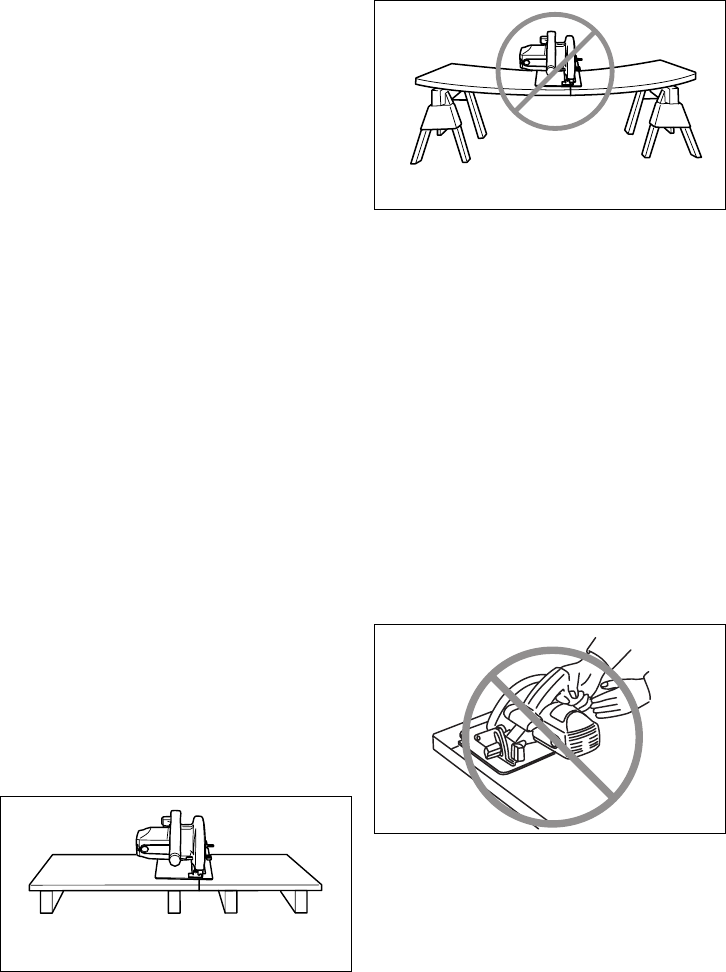
6
9. Causes and Operator Prevention of Kickback:
– kickback is a sudden reaction to a pinched, bound
or misaligned saw blade, causing an uncontrolled
saw to lift up and out of the workpiece toward the
operator;
– when the blade is pinched or bound tightly by the
kerf closing down, the blade stalls and the motor
reaction drives the unit rapidly back toward the
operator;
– if the blade becomes twisted or misaligned in the
cut, the teeth at the back edge of the blade can dig
into the top surface of the wood causing the blade
to climb out of the kerf and jump back toward the
operator.
Kickback is the result of saw misuse and/or incorrect
operating procedures or conditions and can be
avoided by taking proper precautions as given
below.
• Maintain a firm grip with both hands on the
saw and position your arms to resist kickback
forces. Position your body to either side of the
blade, but not in line with the blade. Kickback
could cause the saw to jump backwards, but kick-
back forces can be controlled by the operator, if
proper precautions are taken.
• When blade is binding, or when interrupting a
cut for any reason, release the trigger and hold
the saw motionless in the material until the
blade comes to a complete stop. Never attempt
to remove the saw from the work or pull the
saw backward while the blade is in motion or
kickback may occur. Investigate and take correc-
tive actions to eliminate the cause of blade bind-
ing.
• When restarting a saw in the workpiece, centre
the saw blade in the kerf and check that saw
teeth are not engaged into the material. If saw
blade is binding, it may walk up or kickback from
the workpiece as the saw is restarted.
• Support large panels to minimise the risk of
blade pinching and kickback. Large panels tend
to sag under their own weight. Supports must be
placed under the panel on both sides, near the line
of cut and near the edge of the panel.
• To minimize the risk of blade pinching and kick-
back. When cutting operation requires the resting
of the saw on the workpiece, the saw should be
rested on the larger portion and the smaller piece
cut off. (Fig. B & C)
Fig. B
Fig. C
• Do not use dull or damaged blades. Unsharp-
ened or improperly set blades produce narrow kerf
causing excessive friction, blade binding and kick-
back. Keep blade sharp and clean. Gum and wood
pitch hardened on blades slows saw and
increases potential for kickback. Keep blade clean
by first removing it from tool, then cleaning it with
gum and pitch remover, hot water or kerosene.
Never use gasoline.
• Blade depth and bevel adjusting locking levers
must be tight and secure before making cut. If
blade adjustment shifts while cutting, it may cause
binding and kickback.
• Use extra caution when making a “plunge cut”
into existing walls or other blind areas. The
protruding blade may cut objects that can cause
kickback. For plunge cuts, retract lower guard
using retracting handle.
• ALWAYS hold the tool firmly with both hands.
NEVER place your hand or fingers behind the
saw. If kickback occurs, the saw could easily jump
backwards over your hand, leading to serious per-
sonal injury. (Fig. D)
Fig. D
• Never force the saw. Forcing the saw can
cause uneven cuts, loss of accuracy, and pos-
sible kickback. Push the saw forward at a speed
so that the blade cuts without slowing.
To avoid kickback, do support board or panel
near the cut.
Don’t support board or panel away from the cut.


















